Étiquette : Chaldean
Rembrandt: 400 years old and still young!
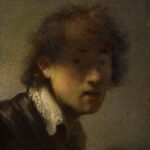
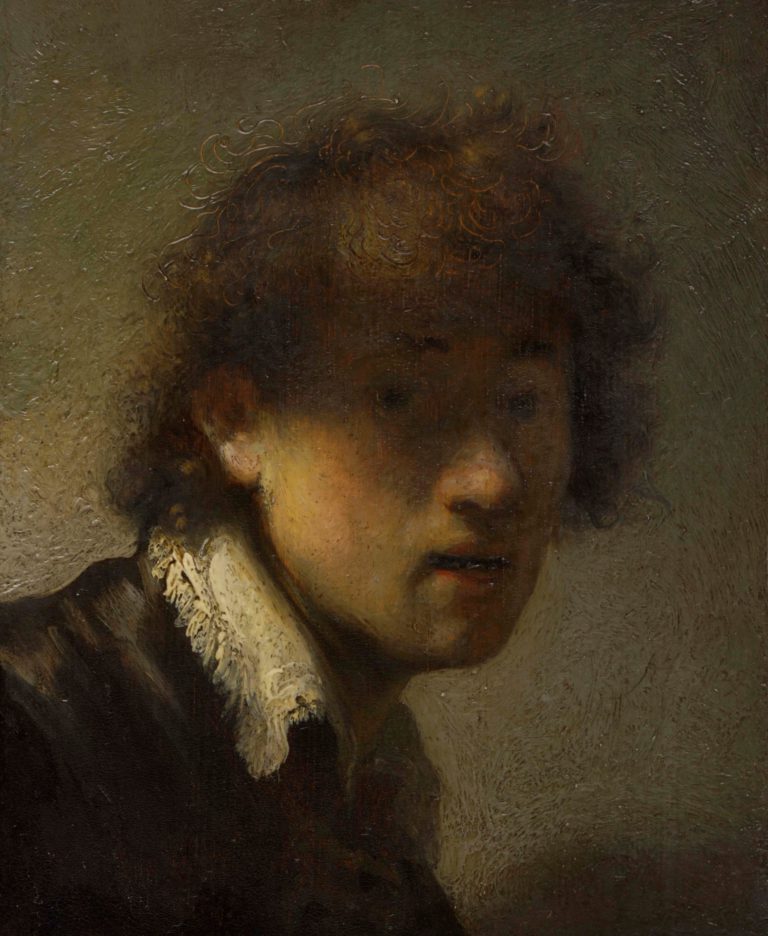
Rembrandt H. van Ryn, was born on July 15, 1606, as the son of a not so poor miller living in the revolutionary city of Leyden in the Netherlands.
Today (2006), four hundred years later, even without any knowledge of the specific historical context, few are those that remain indifferent to his artistic message and skill. Why Rembrandt? What particular quality of his paintings, engravings and drawings gave him the power to reach over centuries of time?
As we will document here, Rembrandt, a precocious intellectual, became already quite « universal » as a young adult. But let’s try to find out what « universal » means.
The Revolt of the Netherlands
The revolt of the Burgundian Netherlands (Note 1) against the tyranny the Fuggers, bankers at the helm of the Spanish and Austrian Habsburg empire, resulted in the tragic break-up of this « nation-state in the making » between the north (today’s Netherlands) and the south (the territory that today includes Belgium and part of northern France).
The Habsburg empire, while brutally sticking to the rich southern part (Flanders), cynically offered the « insurgents » that, if they wished to have a country, they could settle in the malaria-infested swamps of the North, where 75% of the territory lies below sea level, but nevertheless an area slowly domesticated by generations of hardworking farmers thanks to a vast system of canals, dikes and locks, patiently erected since the end of the thirteenth century.
But Charles V, and even worse, his son Philip II of Spain, didn’t believe in the power of mind or that of work. Instead, they believed in the power of the sword and the terror of the Inquisition. After a long war and much unnecessary bloodshed, their policies had reached an impasse, and on April 9, 1609, the semi-bankrupt Habsburgs were forced to sign a twelve-year truce with the new Republic of the Netherlands.
Education
That same year, Rembrandt, hardly 3 years old, entered basic school, where girls and boys learn to read, to write and to calculate. School opens at 6 a.m. in the summer, at 7 a.m. in winter, and finishes only at 7 p.m. Classes start with prayer, the reading and discussion of passages of the Bible and the singing of psalms. Here Rembrandt develops an elegant handwriting and more than rudiments of the Bible.
The Netherlands want to survive. Its leaders wisely used the 12 year truce (1609-1621) to fulfill their commitment to the general welfare. This way, early XVIIth century Holland became maybe the first country of the world where everybody got the chance to learn how to read, write and calculate.
That universal school system, whatever its inadequacies, offered to both poor and rich alike, was the secret of the Dutch « Golden Century ». It’s schooling will also create the generations of Dutch immigrants that will participate a hundred years afterwards in the American Revolution
Others would enter the secondary school at the age of 12, but Rembrandt precociously enters Leyden’s Latin School at the age of 7. There, pupils generally, besides rhetoric, logic and calligraphy, learn, not only Greek and Latin, but English, French, Spanish or Portuguese. Then, in 1620, at the age of 14, since no age limit in the Netherlands bridled young talents, Rembrandt inscribed at the Leyden University. His choice is not Theology, Law, Science, nor Medicine, but Literature.
Did Rembrandt want to add to his knowledge of Latin, the mastery of Greek and Hebrew philology and perhaps Chaldean, Coptic or Arabic? After all, Leyden was already publishing Arabic-Latin dictionaries, while the Netherlands were increasingly growing to become the book printing centre of the world.
From its foundation in 1585, after a historic battle for the city’s freedom, Leyden University became a rallying point for humanists worldwide and a center for new discoveries in optics, physics, anatomy and cartography, offering the world such famous scientists as Christian Huygens (1629-1695) and Antonie van Leeuwenhoek (1632-1723), both correspondents of Leibniz.
People flocked in from Flanders, Germany, Denmark, Sweden, England and even Hungary. By 1621, over fifty Frenchmen were teaching in Leyden. In a desperate effort to pollute this source of creativity, in 1630, René Descartes registered as a « mathematician » at the University of Leyden. (Note 2)
But the big trouble had already started way before. A disastrous theological « debate » degenerated into a conflict akin to civil war. On the one side, Jacob Arminius, founder of the « Remonstrant » current upholding the Erasmian-Rabelaisian concept of man endowed with a free will although that free will remained to be fine-tuned with the grace of God. This view was also held by the elder general and capable national leader, Johan van Oldenbarnevelt (1547-1619).
On the opposing side, one Franciscus Gomarus, defender of the fatalist Calvinist doctrine of « predestination », a doctrine adhered to by Prince Maurits, the young incoming son of the founder of the nation, William the Silent. While leaders were strongly divided, the 1619 « Dordrecht Synod » installed the radical Calvinist doctrine as the law.
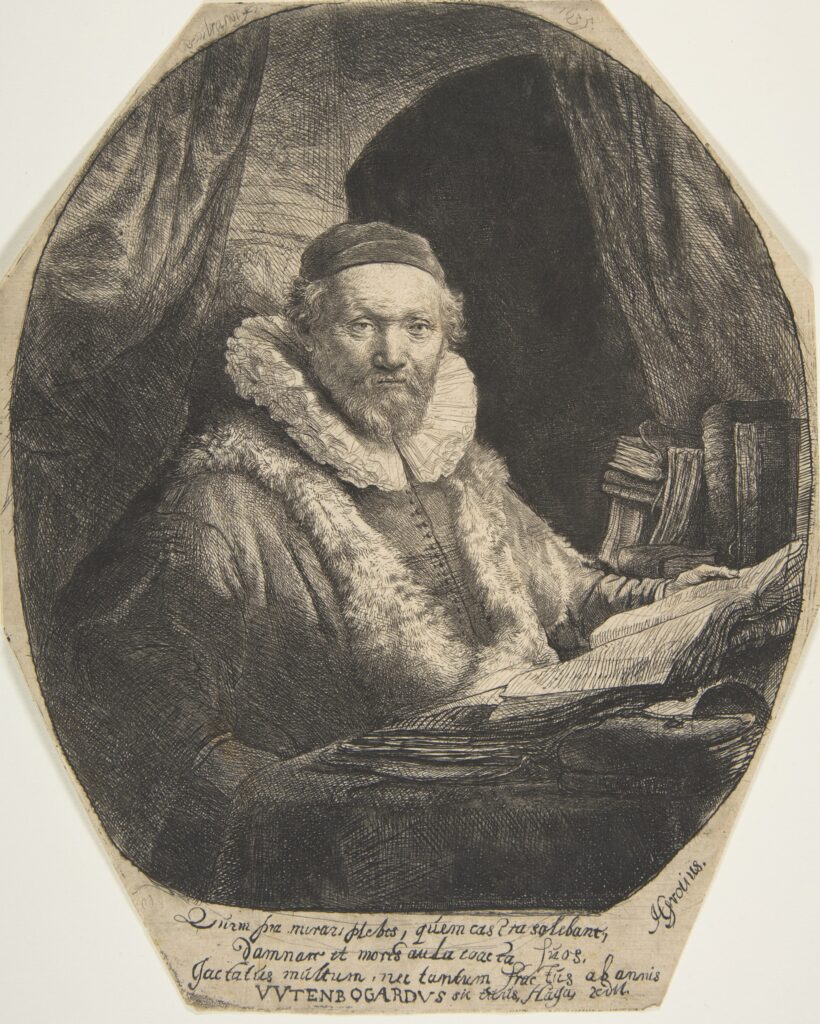
But Leyden was mostly « Arminian » and so was Rembrandt. Rembrandt’s 1633 and 1635 portraits of Johannes Uytenbogaert, the main reverend leading the Arminians who was obliged to spent several years of his life in exile to escape from persecution, show how closely Rembrandt was connected to this movement.
So, when Rembrandt entered University, the situation was very hot. Arminian-minded teachers are on the leave and often forced to do so. So was Rembrandt, and after two months, at age 14, he quitted University and went full time into painting and set up his own workshop.
By 1621, the truce had come to an end, and the Spanish army was once again conducting an all-out war against the Netherlands, which was accused, not without reason, of supporting the Bohemian revolt and harboring the leaders of its resistance. (Note 3)
As a young intellectual confronted with injustice and political and religious madness, Rembrandt entered the studio of Jacob Isaaczoon van Swanenburg, a learned Dutch painter who lived in Venice and Naples, where he worked from 1600 to 1617 before running into trouble with the Inquisition, which accused him of « painting on Sundays ».
Few works have survived from this master, renowned for his city views and portraits. But his subjects and style resemble those of the great humanist Hieronymus Bosch. For three long years, Rembrandt learned how to grind pigments, master essences, varnishes, brushes, canvases and panels.
But above all, Swanenburgh made his pupil a master in the art of engraving and etching.
Pelgrims of Emmaus

Rembrandt’s interest in the power of ideas clearly appears in the « Pilgrims at Emmaus », where an atmosphere of astonishment and horror break out when Christ reveals himself to the disbelievers.
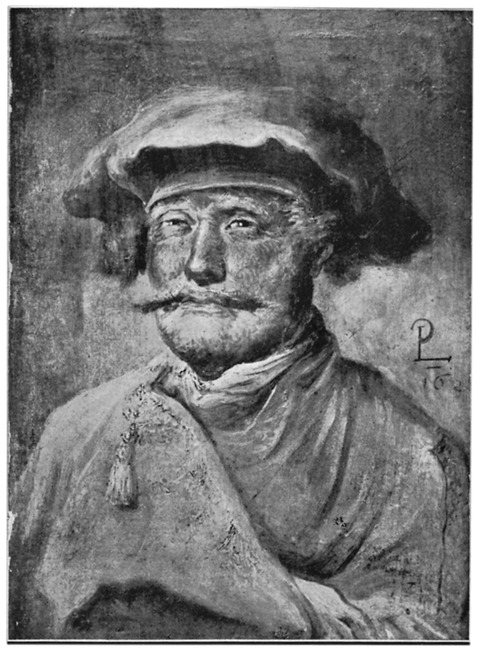
Then, before setting up his studio, Rembrandt will spend six months in the workshop of Pieter Lastman in Amsterdam. With Lastman, Rembrandt finally finds a master that departs from the traditional Dutch landscapes, still-lives and boring group portraits.
Building on the theatrical settings of Caravaggio, Lastman paints biblical, Greek and Roman mythology. He paints history! And Rembrandt always desired to become a historieschilder. Now, Rembrandt finally found in painting the literature he was looking for when inscribing in the University.
Also, in Lastman’s workshop, he meets the talented Jan Lievens, with whom he will work for a while.
Knowing how to know thyself
Rembrandts reputation is largely the fruit of the near to one hundred multiform self-portraits, including about twenty engravings, covering the walls of numerous museums around the world. Some pragmatists tell us Rembrandt did that many self-portraits because he just was the cheapest model in town, and probably the most patient one. Others claim he was simply noting down his unending grimaces, the famous tronies, to prepare future dramatic historical paintings.
We think there is more to it and we approve Simon Schama who wrote that, « The reason for the multiplication of his self-image was not a relentless, almost monomaniacal assertion of the artistic ego but something like the exact opposite. »
The self-portrait, an art expression that has nearly disappeared from today’s practice, always throws an extremely daring challenge to the painter looking into the mirror. Is this me? I didn’t realize I look that way. I’ve changed again! What is wrong? The a priori ideas in the mind of the perceiver or the sense perceptions he’s confronted with? Real thinking, in essence, comes down to confronting not just those burning paradoxes, but the joy of overcoming them with self reflexive irony, and a truthful commitment to the permanent discovery and communication of that increasing irony through a Socratic dialogue.
Rembrandt, at the age of 22 starts training his first pupil, Gerrit Dou, only fifteen years old. Samuel van Hoogstraten, who was another young pupil, reported Rembrandt advising him:
« Try to learn introducing in your work what you know already. Then, very soon, you will discover what escapes you and want to discover. »

Hoogstraten’s self-portrait at age 17 demonstrates what a contagious genius Rembrandt became rapidly as a teacher.
But Rembrandt’s main problem was to show movement. Anima means soul and for Rembrandt animating the mind of the viewer was the art of making that viewer conscious of his own quality of moving the soul, i.e. moving the mover. Through this process of teaching and self-teaching Rembrandt works out various ways to tell his-stories.
One funny way to put faces into motion is to wrap them into clothing, put on jewelry, and choose a specific light setting that generates interesting eye-attracting shadows bringing into light the plastic volumes. Explore facial expressions evoking anger, fear, happiness, self-doubt, laughter, etc.
The real subject is not Rembrandt, but the discovery of human consciousness through self-consciousness. The mirror image permits oneself to look over one’s shoulder down on oneself. Leonardo and others advised artists to view their own work in a mirror, since the « fresh » mirror image offered the artist another « viewpoint », revealing those remaining imperfections that had escaped from his attention.

Also, the compassion and self esteem one is forced to develop in that process becomes a basic ingredient for promethean and agapic character formation. Then, Rembrandt’s joyful process of self-discovery spills naturally over into the portraits done of others.
Look how funny Saskia smiles, when she dresses up « as Rembrandt » with a feathered reddish hat, carrying a golden chain and with her little hand lost in Rembrandt’s large glove.
Then, there are also the self-portraits in assistenza, where the painter’s face pops up uninvited in a larger painting, such as in Velazquez‘ « Las Meninas ».
The Stoning of Saint-Stephen
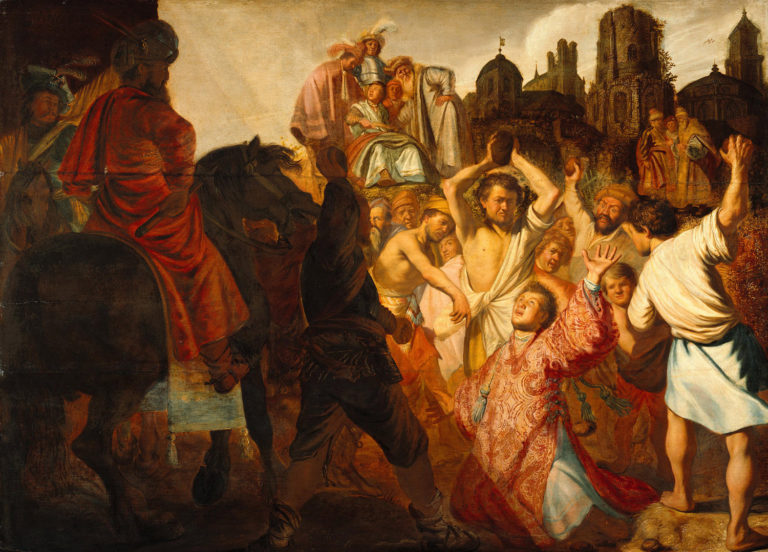
One of Rembrandt’s grimacing faces appears behind the martyr in the first known painting by the young Rembrandt, The Stoning of Saint-Stephen. Executed at the age of 19, the work powerfully expresses the basis of Rembrandt’s ideas. Loaded with some twenty figures, the subject had previously been treated by Lastman and Adam Elsheimer, a young German Mannerist living in Rome, whose works Rembrandt had admired while contemplating reproductions in Swanenburgh’s studio.
But why Saint-Stephen? Rembrandt’s choice stems directly from the subject. This Greek-speaking Jewish convert, the first Christian martyr, was tried by a court of law for blasphemy. He unabashedly told the Sanhedrin judges that they were « stiff-necked and uncircumcised in heart and ears » and that they were people who had « received the law by the disposition of angels, and have not kept it… »
Stephen also told them that God could not be kept « locked up in a temple ». At one point, Stephen,
« being full of the Holy Spirit, and having his eyes fixed on heaven, saw the glory of God, and Jesus standing at the right hand of God, and he said: ‘Behold, I see the heavens opened, and the Son of Man standing at the right hand of God’.
« And crying aloud, they stopped their ears, and with one accord rushed upon him; and having pushed him out of the city, they stoned him; and the witnesses laid their garments at the feet of a young man called Saul. And they stoned Stephen, who prayed and said: Lord Jesus, receive my spirit. And kneeling down, he cried aloud: Lord, do not impute this sin to them. »
The painting leaves the left side entirely in shadow, in a partially failed attempt to evoke the idea of Stephen seeing the « open heavens. » Saul is in the shadows because he is the one encouraging the execution. Later, on the road to Damascus, he would have his own vision of the « heavens opening » and in turn convert to Christianity, since Saul is none other than the future St. Paul.
In short, as we have said, at the age of 19, Rembrandt powerfully asserts the principles for which he wants to live and for which he is prepared to die, ideas that he must have discovered at the age of fourteen during the great Sophist event, the great « theological debate » that was the beginning of the end of the Republic.
Ideas
Historians might scream there is no space here for political manifestos. They are right. Rembrandt’s ideas go far beyond simple minded militantism, and their political impact is much more profound.
In 1641, an artist, Philips Angel, adressing the painting guild, honored Rembrandt and underscored the artist’s « elevated and profound reflection ». What were these « elevated and profound » ideas all about?
- Truth. Somebody must mobilize the courage to stand up and tell the truth in front of established authorities or misleading public opinion. That theme comes regularly back, notably with « Suzanna and the Elders ». Daniel, a witness of injustice will speak up and saves Suzanna from the death sentence.
- Reason. Faith and religion do not always coincide with religious rites. Look to the angry angel preventing Abraham from killing his own son in « The sacrifice of Isaac ». Think before acting! Reason, love of God and love for mankind must guide any religious practice and on the basis of reason, a dialogue of cultures can enrich humanity.
- Self-perfection. Change, yes. People can find in themselves the means to identify their errors and change for the better. The example of Saint-Paul will stand as a permanent reference for Rembrandt, who painted him several times and even represented himself as the Church father.
- Love, Repentance, Pardon. In a period of permanent danger of « religious wars », Rembrandt strongly identifies with Saint Stephen’s demand « Lord, lay not this sin to their charge. » Rembrandt will paint several times « The return of the prodigal son ». The father gives a great feast for the returning son because he « who was dead came back to life ». The notion of pardon, and acting in the advantage of the other, will become the key concept for the success of the world Peace of Westphalia concluded in 1648 ending the thirty years war, including the recognition of the Netherlands as a sovereign state.
The Night Watch

Misrepresented as a nocturnal scene, the Night Watch is probably one of the greatest intellectual provocations against cold Aristotelian classicism.
The Netherlands was at war. Amsterdam, like most major cities, maintained a considerable militia of archers, crossbowmen and harquebusiers. These small citizen armies had a firing range and a meeting hall, the Kloveniersdoelen, where soldiers could rest after training.
Obviously, such glorious gatherings deserved to be immortalized in vast group portraits, where all the members of the company was presented in such a way that, as van Hoogstraten put it, « you could, as it were, behead them all with a single cannon shot. »
Rembrandt completely overturned this traditional representation. Firstly, apart from the 2 captains and their 16 companions (who each paid for their presence on the canvas), Rembrandt added another third of figures to the original number.
Secondly, the revolutionary concept implemented is the idea of depicting the whole group as « on the march », not just advancing, but raising flags and weapons after passing under a circular arch seen just behind them.
Thirdly, a spectacular sense of movement emanates from the rapid oscillation of a chiaro-oscura, illuminating one part, casting another into shadow.
Finally, the show seems formally a confused, chaotic scene. People enter from all sides. In infinite heteronomy, one loads his rifle, another beats the drum, another raises his spear while another stares at his rifle.
Beyond this apparent hectic confusion, what remains is the spirit of a republican citizenry called to arms and moving from chaos to unity, a subject Rembrandt represented the same year in an allegorical oil sketch, Concord of the State.
Against narrow academic rigor, the spirit of inclusion of the multitude so common to Flemish painters like Bruegel was once again manifesting itself.
Van Hoogstraten, defending Rembrandt against these critics (as usual, those who were jealous of his brilliant performance) commented:
« Rembrandt observed this requirement [of unity] very well… and although in the opinion of many he went too far, making the painting more according to his personal taste than according to the individual portraits he had been commissioned to paint.
Nevertheless, the painting, no matter how harsh the critics, will stand, in my judgment, against all these rivals because it is so picturesque in its conception and because it is so powerful that, according to some, all the other doelen works look like playing cards in comparison. »
Immortality
We took here just a few examples to demonstrate that Rembrandts universal character derives directly from his ruthless commitment, directed to make us conscious of the creative potential given to all human beings, men and women, old and young, Christians, Jews, Muslims or others, a creative and creating human nature called the soul.
This commitment is once again available in today’s new generation and can therefore be mobilized for great achievements.
From this point of view, Rembrandt is in a good position to become a reference individual capable of leading us out of the current cultural « dark age », where video games teach our children to take perverse pleasure in gratuitous violence and push them to become « naturally born killers ».
In contrast, a Rembrandt who catches life and loves mankind will trace the divine in the slightest spark of light. As some sort of 5th apostel, without ever painting God directly, Rembrandt reveals the harmony of his creation.
Those who took time studying his paintings can tell themselves: « God exists, I just met Rembrandt », since through Rembrandt’s art God’s tender love and blessing power are revealed to us in our human reality.
That « immortal » nature of Rembrandt’s soul will doubtlessly nourish the « immortality » of the creative geniuses he will inspire. Let us not wait another four hundred years to celebrate such a genius, for what he brings us is living and not to be buried in the history of art
Notes:
- Friedrich Schiller, The revolt of the Netherlands; Karel Vereycken, How Erasmus Folly saved our Civilization; Karel Vereycken, « Rembrandt, bâtisseur de nations » in Nouvelle Solidarité, June 10 and 17, 1985.
- Years earlier, René Descartes, using his own funds, made a trip to Bohemia and in 1620 took part in the battle of Montagne Blanche, leading to the massacre of Prague, the capital of Bohemia. One biographer reports that Descartes, entering Prague, immediately appropriated Kepler’s Brahe scientific instruments.
- For a detailed report on the links between Rembrandt and Comenius and the Bohemian revolt, see Karel Vereycken, The light of Agapê, Rembrandt and Comenius versus Rubens, Ibykus N°85, 2003.
- Ernst van Wetering, director of the Rembrandt Research Project (RRP), on the basis of scientific examinations of Rembrandt’s works, estimates that the master required his models to pose for three hours a day for at least three months.
- Karel Vereycken, Leonardo, painter of movement, Fusion N°108, 2006.